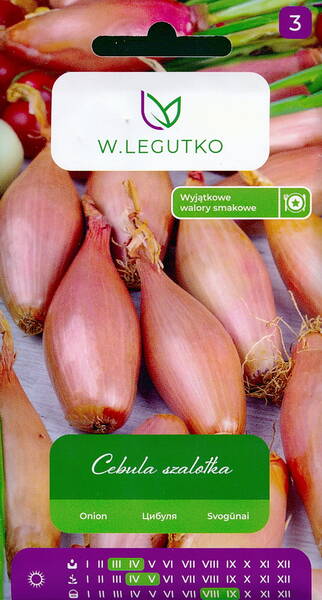The spiciest of all bows!
Scallion is a spicy vegetable, a biennial herbaceous plant of the onion family. It is less pungent in taste compared to hibernal onions, and more fragrant and fragrant than leeks.
Considered a gourmet onion, it is included in many recipes in French cuisine. It is used fresh as a seasoning for salads, soups, and snacks. Contains more than hibernal onion sugars, ascorbic acid, and dry matter.
* The favorite crop of many peoples is the aristocrat shallot: the onion is tender, juicy, tasty and aromatic.
It is especially appreciated by gourmets - it is believed that shallots do not drown out the delicate taste of other products.
Shallot bulbs are very similar to onion bulbs, but smaller. But they keep well! They form many shoots - up to 30 or more in one nest. The leaves are thinner than those of onion, subulate, bright green, up to 20-40 cm long, tender and aromatic, and how good they are in salads! Their main advantage is that they do not become rough for a long time.
Another distinctive feature of shallots is its early ripeness: after planting, it grows quickly, after 25-30 days the greens can be cut, and the bulb itself ripens in 70-80 days (20-30 days earlier than onions).
The productivity of shallots is high. Greens can be collected up to 5 kg/sq.m, bulbs up to 3 kg/sq.m. In addition, the bulbs are cold-resistant: they can freeze, and after gradual thawing they can germinate as if nothing had happened.
An important quality is the ability to be stored well: it does not dry out, does not germinate at room temperature, and can be stored without problems until the next harvest.
This onion has a deep but short dormant period, so it is very convenient for winter and early spring forcing. And if shallots are planted in the ground in the fall, then in the spring its greens will be ready for use 10-15 days earlier than onion greens. If you plant shallots in July-August, a wonderful harvest of greenery will ripen in the fall (this is unlikely to happen with onions).
In spring, shallots are planted as early as possible - just so that the ground warms up a little. When the soil is sufficiently moist and cold (+8+10°C), intensive root growth occurs, which outstrips leaf growth.
Late planting is undesirable: the soil becomes dry and warm, as a result of which the growth of leaves will outpace the growth of roots, that is, the plants will begin to suffer from a lack of water and nutrients. The bulbs become smaller, ripen poorly (you get a lot of “thick necks”), and the likelihood of being damaged by onion fly larvae increases.
Shallot plants produce a large rosette of green leaves, so they require good light. The distance between rows should be 30-50 cm, between plants in a row 10-20 cm (the smaller the planting material, the higher the planting density). You can grow shallots according to the 20x20 cm or 30x30 cm pattern. To obtain larger shallot bulbs, you need to cut the shallots into several parts, so from one large onion, cutting off the “tail” and dividing the bulb into parts, you can get up to 10 planting units, of which 3 will grow -4-nest large families up to 150-170 g. The bulbs are planted to a depth of 5-6 cm, so that there is a 2-3 cm layer of soil above them. Planting too shallow can lead to the bulbs sticking out of the ground (especially on heavy soils).
If the planting material is buried, the new bulbs will not ripen well and become smaller.
How to care for shallots?
Be sure to loosen the soil around the plants to prevent crust formation. Of course, water and feed in the first half of the growing season. Fertilizing in July is ineffective (and nitrogen fertilizers are harmful). In the first ten days of July, you can standardize the bulbs in the nest. Carefully rake the soil away from the plants and completely remove 2-3 branches in the area with the bulb, leaving 2-3 shoots (the bulbs will become larger).
Harvest shallots after lodging of leaves. You should not delay harvesting, as this will not increase the yield and reduce the shelf life of the bulbs. The leaves usually dry well, they can be braided or, without cutting with scissors, simply picked off with your fingers and placed in a lattice box.
Shallots are best stored at a temperature of 0°C or +1°C and a relative humidity of 60-70%. If you have to store the shallots in a warm place, it is better to dust them with ash or chalk.















